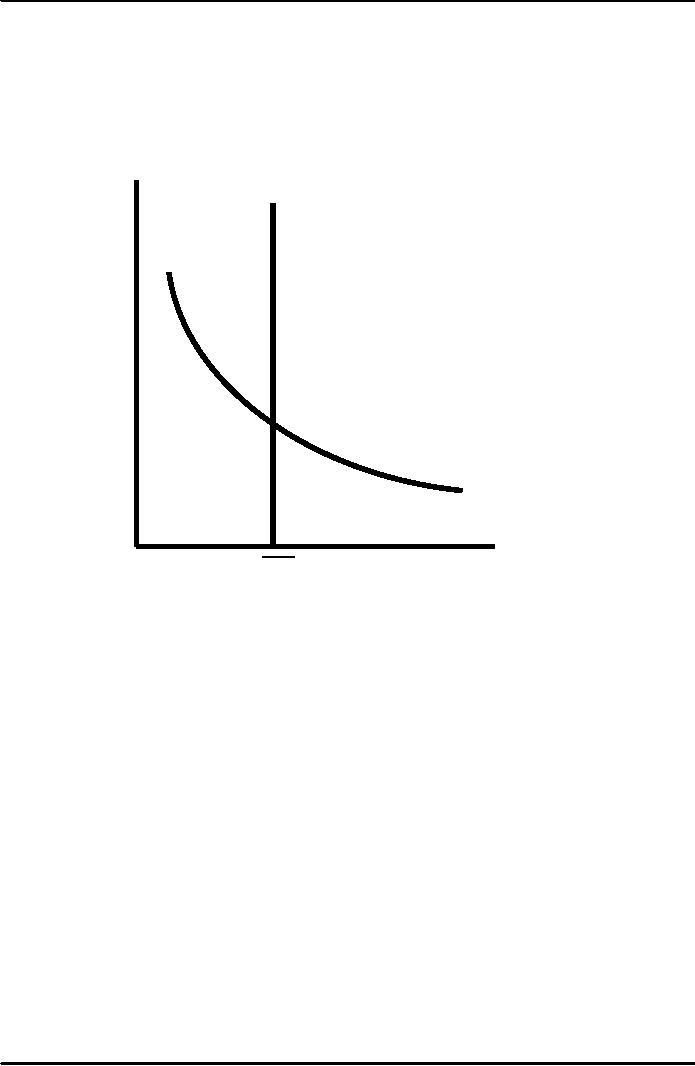 |
INVESTMENT:The Rental Price of Capital, The Cost of Capital |
| << CONSUMPTION (Continued…):The Life-cycle Consumption Function |
| INVESTMENT (Continued…):The Determinants of Investment >> |

Macroeconomics
ECO 403
VU
LESSON
40
INVESTMENT
�
Investment
is the most volatile
component of GDP. When expenditure on
goods and
services
fall during a recession,
much of the decline is
usually due to a drop in
investment
spending.
�
Economists
study investment to better
understand the fluctuations in
the economy's output
of
goods and services.
�
The
models of GDP, such as IS-LM
model, were based on a
simple investment
function
relating
investment to real interest
rate: I = I(r)
�
That
function states that an
increase in the real
interest rate reduces
Investment.
�
Here
we look more closely at the
theory behind this
investment function.
Three
types of Investment
Spending
�
We
shall build models of each
type of investment to explain
the fluctuations in the
economy.
Also
these models will shed
light on the questions such
as:
Why is
investment negatively related to
the interest rate?
What
causes investment function to
shift?
Why does
investment rise during booms
and fall during
recessions?
Business
Fixed Investment
�
The
largest piece of investment
spending (about � of total) is
business fixed
investment
Business:
these investment goods are
bought by firms for use in
future production.
Fixed:
This spending is for capital
that will stay put
for a while (as opposed
for inventory
investment)
�
Business
Fixed investment includes
everything from fax machines
to factories, computers
to
company cars
The
standard model of business
fixed investment is called
the neoclassical
model of
investment.
It
examines the benefits and
costs of owning capital
goods. Here are
three
variables
that shift
investment:
1)
The marginal product of
capital
2)
The interest rate
3)
Tax rules
�
To
develop the model, imagine
that there are two
kinds of firms:
1.
Production firms that
produce goods and services
using the capital that
they
rent
2.
Rental firms that make
all the investments in the
economy.
In
reality, however, most firms
perform both
functions
The
Rental Price of
Capital
�
A
typical production firm
decides how much capital to
rent by comparing the cost
and
benefit
of each unit of
capital.
�
The
firm rents Capital at a
rental rate R and sells
its output at a price
P
�
The
real cost of a unit of
capital to the production
firm is R/P
�
The
real benefit of a unit of
capital is the marginal
product of capital, MPK (the
extra output
produced
with one more unit of
capital)
�
MPK
falls as the amount of
capital rises
189

Macroeconomics
ECO 403
VU
�
So,
to maximize profit, the firm
rents capital until the MPK
falls to:
MPK
= R/P
�
Hence
MPK determines the downward
sloping demand curve for
capital for a firm
�
While
at point in time, the amount
of capital in an economy is fixed, so
supply curve is fixed
�
The
real rental price of capital
adjusts to equilibrate the
demand for capital and
the fixed
supply.
Capital
supply
Real
rental
price,
R/P
Capital
demand (MPK)
K
Capital
stock, K
The
Cobb-Douglas production function
serves as a good approximation of
how the
�
actual
economy turns capital and
labor into goods and
services.
The
Cobb-Douglas production function
is:
�
Y
= AKαL1-α
Where
Y
⇒
is
output
K
⇒
capital
L
⇒
labor
A
⇒
a
parameter measuring the
level of technology
α
⇒
a
parameter between 0 and 1
that measures capital's
share of output.
The
marginal product of capital
(MPK) for the Cobb-Douglas
production function
is:
�
MPK
= αA (L/K)
1-α
Because
the real rental price
(R/P) equals MPK in equilibrium, we
can write:
�
R/P
= αA (L/K)
1-α
This
expression identifies the
variables that determine the
real rental price.
�
It
shows the following:
�
The
lower the stock of capital,
the higher the real
rental price of
capital
�
The
greater the amount of labor
employed, the higher the
real rental price of
capitals
�
The
better the technology, the
higher the real rental
price of capital.
190

Macroeconomics
ECO 403
VU
Events
that reduce the capital
stock, or raise employment, or
improve the technology,
raise
the
equilibrium real rental
price of capital.
The
Cost of Capital
�
The
Rental firms, just like
car rental firms merely
buy capital goods and
rent them out.
�
Let's
consider the benefit and
cost of owning
capital.
The
benefit of owning capital is
the real rental price of
capital R/P for each
unit of capital
it
owns and rents
out.
For
each period of time that a
firm rents out a unit of
capital, the rental firm
bears three costs:
1.
Interest on their loans,
which equals the purchase
price of a unit of capital PK
times the
interest
rate, i, so iPK
2.
The cost of the loss or
gain on the price of capital
denoted as -ΔPK
3.
Depreciation
δ
defined as
the fraction of value lost
per period because of the
wear and
tear,
so δPK
�
Therefore,
Total
cost of capital = iPK -
ΔPK +
δPK
Or
=
PK (i
- ΔPK/PK +δ)
The
cost of capital depends upon
the price of capital, the
interest rate, rate of
change
of
capital prices and the
depreciation rate.
�
Example:
A Car rental company
Buys cars
for Rs.1, 000,000 each
and rents them out to
other businesses
If it faces an
interest rate i of 10% p.a.
so the interest cost,
iPk = Rs.100, 000
p.a.
Car
prices are rising @ 6% per
year, so excluding maintenance
costs the firm gets
a
capital
gain, ΔPk =
Rs.60,000 p.a
Cars
depreciate @ 20% p.a. so
loss due to wear and
tear,
δPk =
Rs.200, 000
�
So,
Total
cost of capital = iPK -
ΔPK +
δPK
=
100,000 60,000
+200,000
=
Rs.240, 000
Summary
�
Investment
Business
Fixed Investment
�
Rental Price
of Capital
�
Cost of
Capital
191
Table of Contents:
- INTRODUCTION:COURSE DESCRIPTION, TEN PRINCIPLES OF ECONOMICS
- PRINCIPLE OF MACROECONOMICS:People Face Tradeoffs
- IMPORTANCE OF MACROECONOMICS:Interest rates and rental payments
- THE DATA OF MACROECONOMICS:Rules for computing GDP
- THE DATA OF MACROECONOMICS (Continued…):Components of Expenditures
- THE DATA OF MACROECONOMICS (Continued…):How to construct the CPI
- NATIONAL INCOME: WHERE IT COMES FROM AND WHERE IT GOES
- NATIONAL INCOME: WHERE IT COMES FROM AND WHERE IT GOES (Continued…)
- NATIONAL INCOME: WHERE IT COMES FROM AND WHERE IT GOES (Continued…)
- NATIONAL INCOME: WHERE IT COMES FROM AND WHERE IT GOES (Continued…)
- MONEY AND INFLATION:The Quantity Equation, Inflation and interest rates
- MONEY AND INFLATION (Continued…):Money demand and the nominal interest rate
- MONEY AND INFLATION (Continued…):Costs of expected inflation:
- MONEY AND INFLATION (Continued…):The Classical Dichotomy
- OPEN ECONOMY:Three experiments, The nominal exchange rate
- OPEN ECONOMY (Continued…):The Determinants of the Nominal Exchange Rate
- OPEN ECONOMY (Continued…):A first model of the natural rate
- ISSUES IN UNEMPLOYMENT:Public Policy and Job Search
- ECONOMIC GROWTH:THE SOLOW MODEL, Saving and investment
- ECONOMIC GROWTH (Continued…):The Steady State
- ECONOMIC GROWTH (Continued…):The Golden Rule Capital Stock
- ECONOMIC GROWTH (Continued…):The Golden Rule, Policies to promote growth
- ECONOMIC GROWTH (Continued…):Possible problems with industrial policy
- AGGREGATE DEMAND AND AGGREGATE SUPPLY:When prices are sticky
- AGGREGATE DEMAND AND AGGREGATE SUPPLY (Continued…):
- AGGREGATE DEMAND AND AGGREGATE SUPPLY (Continued…):
- AGGREGATE DEMAND AND AGGREGATE SUPPLY (Continued…)
- AGGREGATE DEMAND AND AGGREGATE SUPPLY (Continued…)
- AGGREGATE DEMAND AND AGGREGATE SUPPLY (Continued…)
- AGGREGATE DEMAND IN THE OPEN ECONOMY:Lessons about fiscal policy
- AGGREGATE DEMAND IN THE OPEN ECONOMY(Continued…):Fixed exchange rates
- AGGREGATE DEMAND IN THE OPEN ECONOMY (Continued…):Why income might not rise
- AGGREGATE SUPPLY:The sticky-price model
- AGGREGATE SUPPLY (Continued…):Deriving the Phillips Curve from SRAS
- GOVERNMENT DEBT:Permanent Debt, Floating Debt, Unfunded Debts
- GOVERNMENT DEBT (Continued…):Starting with too little capital,
- CONSUMPTION:Secular Stagnation and Simon Kuznets
- CONSUMPTION (Continued…):Consumer Preferences, Constraints on Borrowings
- CONSUMPTION (Continued…):The Life-cycle Consumption Function
- INVESTMENT:The Rental Price of Capital, The Cost of Capital
- INVESTMENT (Continued…):The Determinants of Investment
- INVESTMENT (Continued…):Financing Constraints, Residential Investment
- INVESTMENT (Continued…):Inventories and the Real Interest Rate
- MONEY:Money Supply, Fractional Reserve Banking,
- MONEY (Continued…):Three Instruments of Money Supply, Money Demand